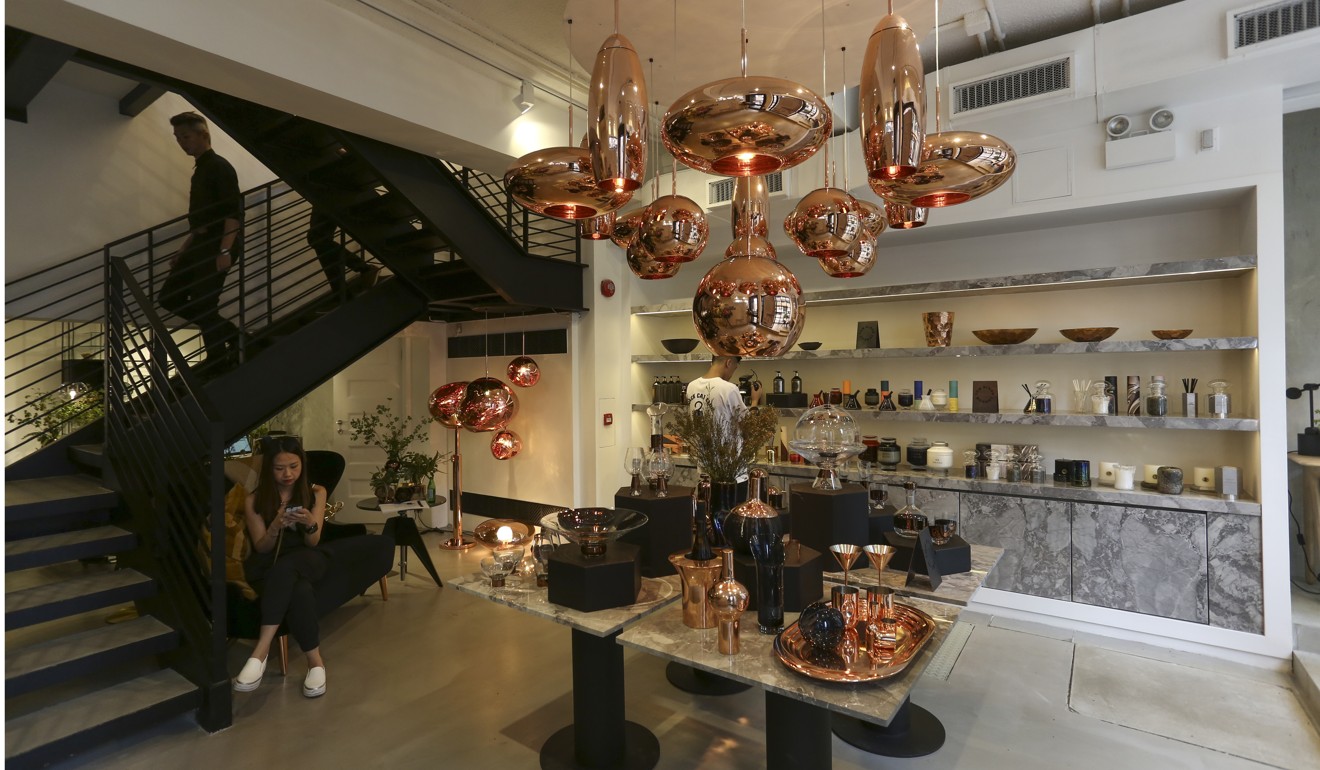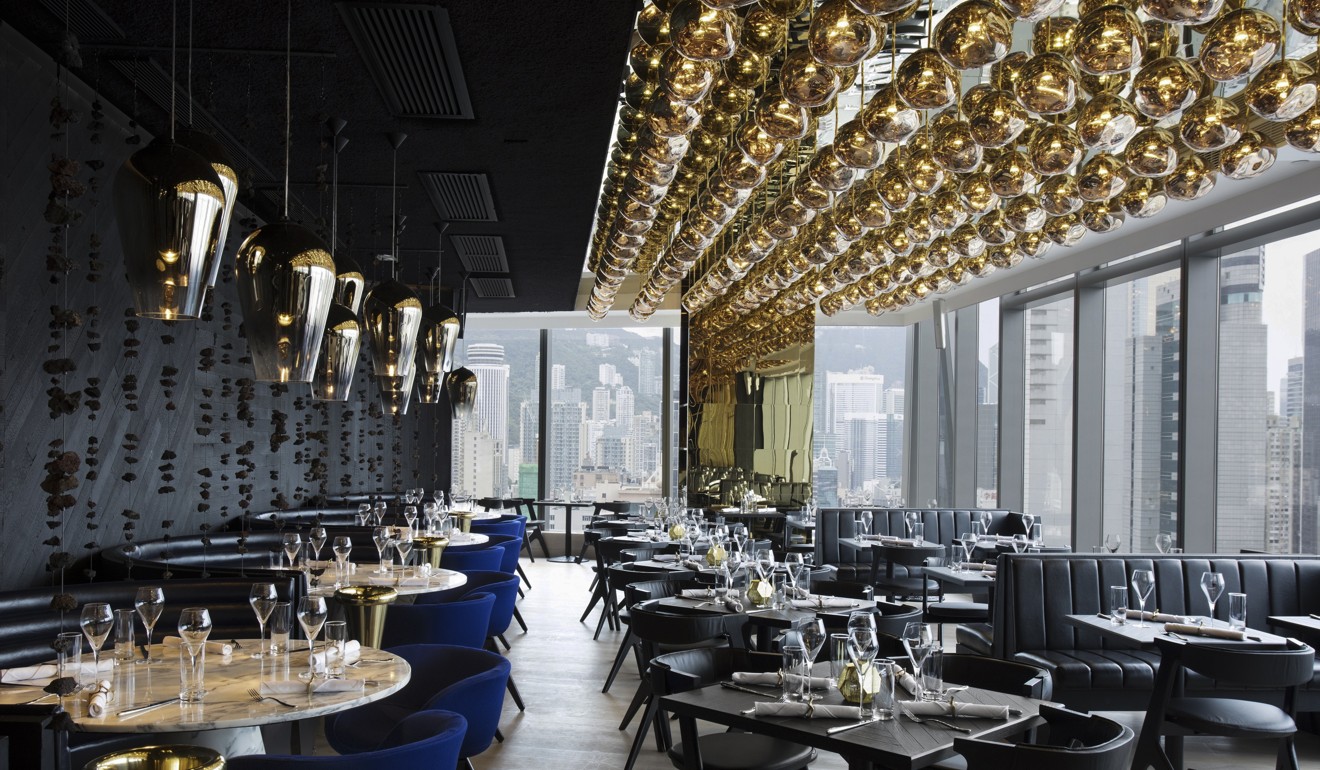
How China’s copycats spur designer Tom Dixon to innovate, and why opportunity knocks in Hong Kong
Star designer sees newly opened shop in Central not just as a retail operation but a showroom, and is amused he’s known in Hong Kong as the ‘perfume person’ thanks to sideline in candles
British industrial designer Tom Dixon admits to still feeling awkward talking about himself as a brand.
“It’s kind of weird to see your name separate from yourself and be sold as a commodity,” says Dixon, 58, who was in Hong Kong recently visiting his first boutique in the city.
“Sometimes I get a bit bored with being ‘Tom Dixon’,” he says wryly, dressed in a tailored wool check suit despite the stifling heat.
But he does enjoy the freedom to do what he likes. At least for now.
“If you look at fashion, and people like Martin Margiela and Jil Sander, it’s very easy to lose your name,” he says, referring to the fashion designers who lost control of their eponymous labels. “When that happens, I guess I’ll worry about the decisions I made,” he says with a grin.
Despite his slight discomfort with being a brand, Dixon belongs to a select group of star industrial designers who have democratised design and taken it to the masses. Like Philippe Starck, Marc Newson and Thomas Heatherwick, among others, Dixon has been able to parlay his name and designs into commercial success but also retain credibility. “If I can interest people in design, that’s enough,” he says.

There is an energy in London in music, in food and product design ... It’s an attitude to creation that’s recognised internationally
Since he left his lofty position as the creative director of household furnishings retailer Habitat in 2008 to devote himself to his eponymous brand (begun six years earlier), Dixon has made decisions that have proved wildly successful. Apart from having four other stand-alone shops around the world, and a staff of 120, he can boast of designs (including the S-Chair) exhibited in the permanent collections of London’s Victoria & Albert Museum and New York’s Museum of Modern Art.
His Hong Kong store, however, is another step for the company. “We haven’t taken retail very seriously [up until now] because we’ve had very strong contract business with designers and architects and also wholesalers. The range, before, hasn’t been wide enough, essentially, to do retail.”
The Hollywood Road store is on a corner formerly occupied by Ralph Lauren Denim & Supply. Despite opening only recently, it has become an attraction thanks to its imposing brick façade, painted black. Much to Dixon’s amusement, it is proving a popular backdrop for selfies.

Dixon acknowledges furniture retailing has its challenges and is a dying category in some respects. City centre furniture retailing is hamstrung by inadequate space and high rents, and is not helped by slow sales of big-ticket items, he says.
That might explain the importance of the coffee shop, and not just as a place where his designers can meet clients for the contract business. “If we can do something with coffee where you can slow people down, it becomes a showroom for a burgeoning online business as well as contract, and with the retail business downstairs you can just about justify being on Hollywood Road.”
Opening a store in Central at a time when retailers in Hong Kong are struggling could be regarded as a brave move, but not for Dixon. “Retail isn’t doing well, particularly in fashion, [but] … I’ve found that in recessions and troubled times opportunities open up,” he says.
Such an environment can boost sales for others, unfortunately. Dixon’s products are popular with copycats and manufacturers of fakes, particularly in China, but, he says, it doesn’t make him “bitter and twisted”. Instead, he sees it as a sign he’s doing something right and, besides, it encourages innovation to keep one step ahead of the copycats.

Still, he finds the current legal environment for dealing with fakes and copies frustrating. “We’ve had a few attempts at stopping the fakes. The legal system is sometimes against you, even in Australia, where … you are able to sell a rip-off Tom Dixon lamp as long as you call it a Tom Dixon ‘replica’,” he says. “As long as you define it as a copy you are legally able to sell it.”
It’s nice to be the creative director of someone else’s fantasy sometimes
The problem posed by Chinese counterfeiters, however, is especially vexing because they often sell copies of designs and fakes of genuine products that haven’t even hit the market. Then there are the regular problems.
“In mainland China it seems every Starbucks and coffee chain has our lighting. We went to Starbucks China and told them about it; they took them down in one, in Shanghai. But we can’t check them all,” says Dixon.
Hong Kong is less problematic because the brand has had a presence online, and in Lane Crawford, for a number of years, but in China it’s a constant battle because the fakes, he says, have been there longer than Tom Dixon. “When it’s too overt we do something about it, but it’s a game of whack-a-mole,” he says.
Claiming to have “the attention span of a mosquito”, Dixon continues to try other disciplines. In addition to being a musician, a sous chef and a clothes designer, he is now known for his perfumed accessories.
“I’d never imagined I’d be a perfumier,” he says, noting that the success of his candle accessories has seen him dubbed the “candle guy”. “It’s kind of interesting, actually; I’m known more for my chairs in Italy, more for lighting in England, and I’m the ‘perfume person’ in Hong Kong.”
Testament to his restlessness are the interior design marks he has left in Hong Kong. Alto, a restaurant in Causeway Bay, and Tazmania Ballroom, a bar and nightclub in Lan Kwai Fong, both bear his imprimatur, although, unlike the candles, these projects aren’t as widely known.
“It’s nice to be the creative director of someone else’s fantasy sometimes,” he says. “When you make your own products you need to make sure the narrative is clear, that your purpose is clear. When you’re doing interior design you’re at the service of the client.”

In the case of Tazmania Ballroom, that was Hong Kong nightclub impresario Gilbert Yeung. “Gilbert has a very big personality; it was really about Gilbert and his past, it was snooker rooms in Toronto [where he went to college, and worked]. It was a great project for us, as we got to test how our products work in certain environments, developing custom products, and that’s why we intentionally called the interior business Design Research Studio.”
Names may be important to him, but they don’t always tell the full story. “London” sometimes appears in his logo but doesn’t limit the brand’s international aspirations or reach, he says.
“Roots are still important, increasingly in a world which is ‘McDonaldsised’,” he says. “That sense of place is completely formative to my development. There is an energy in London in music, in food and product design, and it’s not necessarily a British or English thing as London is so international. It’s an attitude to creation that’s recognised internationally; a place where things can happen.”
Attitude, and perhaps not a little pride, also underscore the way his company operates.
“We can’t really make more than 20 or 30 [new] items a year,” Dixon says of the discipline of keeping things pure from a design perspective, and not cashing in on the success of a hot item. “At Habitat it was 10,000 pieces and we were changing [the product range] at a rate of 40 per cent a year.” From a design perspective, Dixon says, because his company is “super tight”, “I can do it faster.”
Unlike many industrial designers who create products for companies such as Alessi or Kartell, he says he has a “direct relationship” with the product as designer and manufacturer. It all comes back to the name.
“My name as a vehicle is sort of unusual – normally the designers are given credit for being authors of the work but the product is still the manufacturers’,” he says. “I’m intimately involved in every single thing.”

